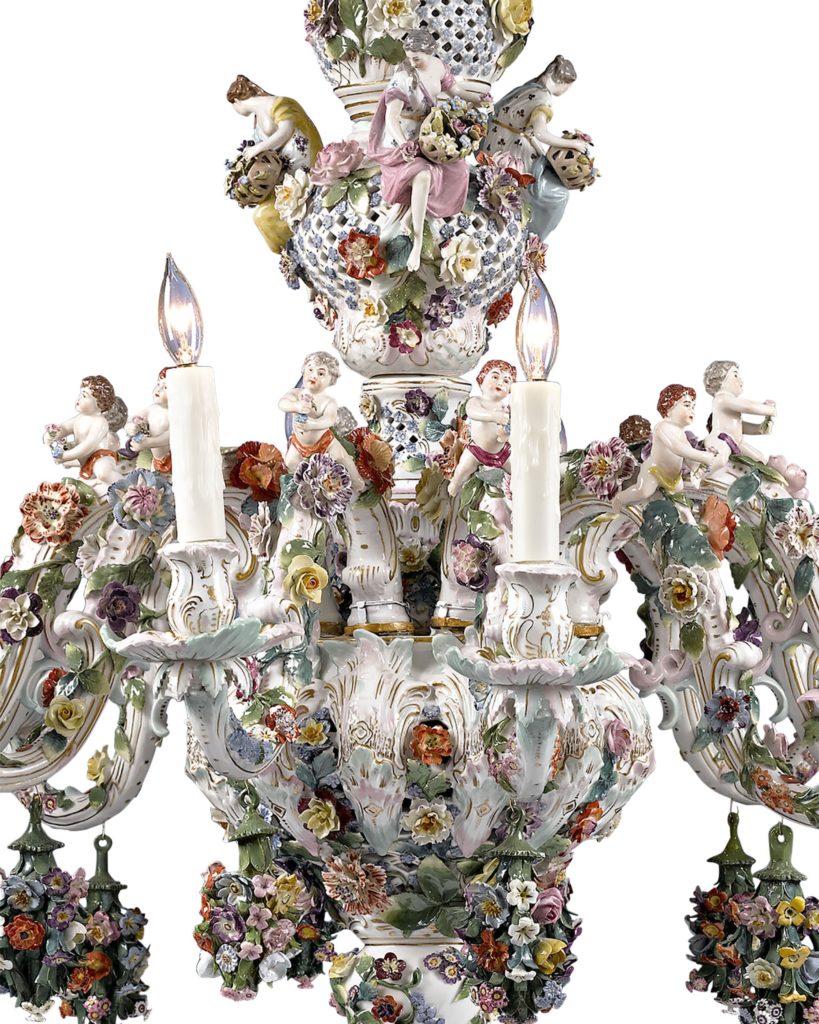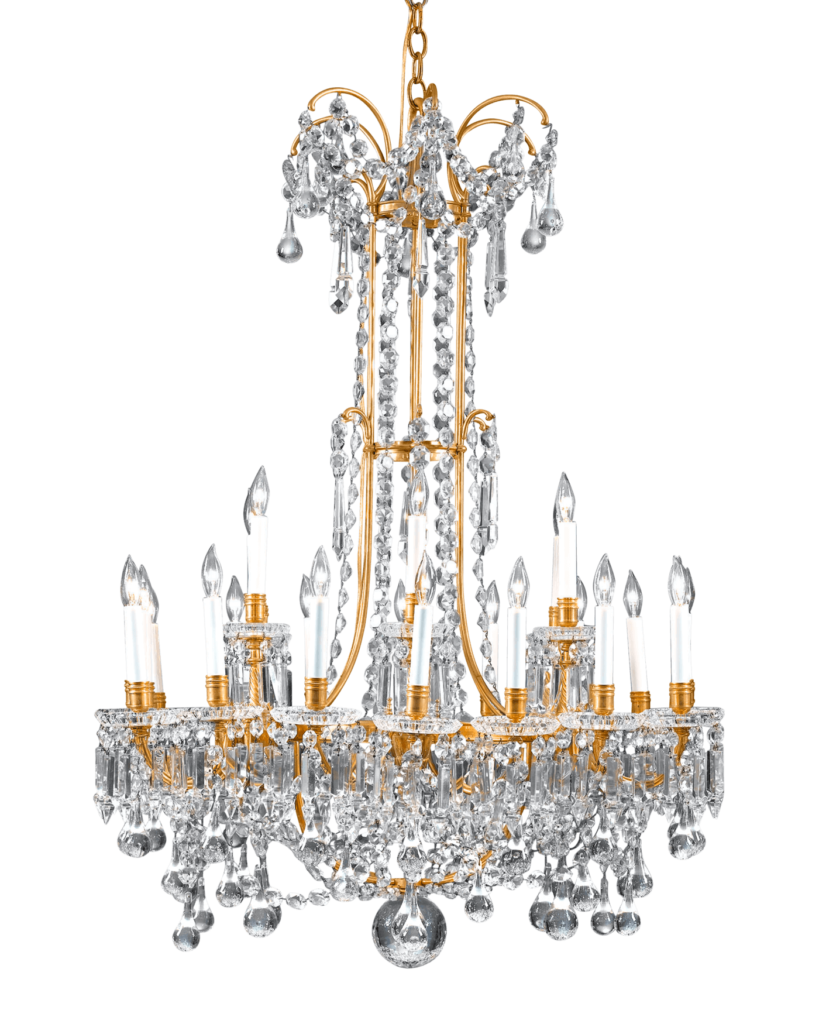
At once dramatic and elegant, there exist very few things that command a room and evoke a sense of splendor quite like a great chandelier. For centuries these magnificent crystal, bronze, and colored glass creations have served as bellwethers of wealth and status, adorning the great halls and dining rooms of Europe and all far reaches of the world. With a myriad of chandeliers available to select from, which is the right one for your home? Before you decide, consider the history, style, and importance of this most functional art form.
The Development of Light: Journey to the Chandelier
Before all else, there was light and dark manifested by nature itself. However, in 400,000 B.C., the discovery of fire profoundly changed the course of human history. As a cultural turning point in human evolution, managed fire meant warmth and protection and, most importantly, light. When and where there was once only darkness, humans had now had access to this lighten their daily and nightly routines and daily light was dramatically different.
Early civilizations, such as Assyria, improved upon the development of human-controlled light and revolutionized lighting with the inventions of tallow lamps and wax candles. In these very early days, light after dark was a true luxury. In fact, candles were considered an expensive luxury and tallow and oil lamps were smelly and smoky; so for most of the population, life was ruled by the rising and setting of the sun. In fact, one could often gauge someone's wealth by the number of candles burning after dark.
Perhaps the most pivotal moment in the development of light occurred during the 7th century Medieval Era with the invention of the chandelier.
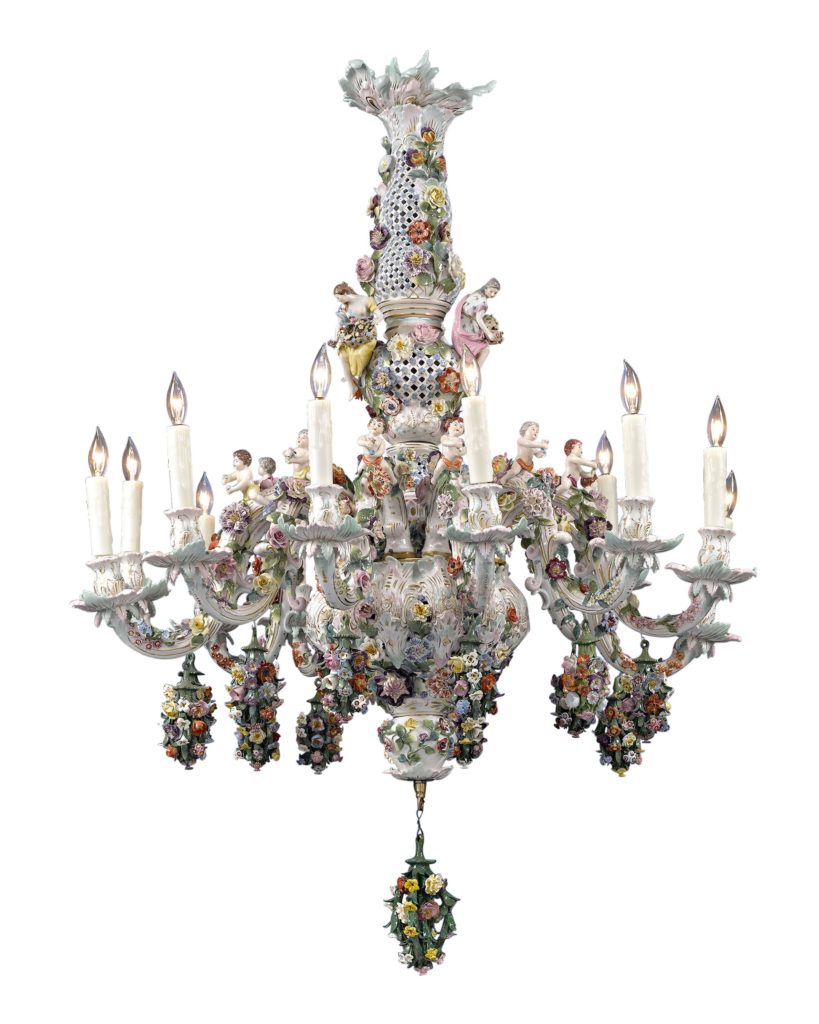
The word chandelier derives from the French term for candlestick. In its very earliest stages, chandeliers were quite different than the ornate, elegant pieces that we are familiar with today. In fact, the earliest chandeliers were not much more than simple, unadorned large candleholders. They were simple crossed timbers suspended from the ceiling and outfitted with prickets or spikes to hold wax candles or cups for oil and a wick. Despite their simplistic form, however, early chandeliers were generally only found in places of worship, and later in the homes of the very wealthy.
Fast forward to the 15th century and, though chandeliers remained inconspicuous and unadorned, new materials were introduced into their creation: strong iron, brass hoops. Even more so, chandeliers began taking on single and multiple levels. Gothic designs were rendered in metal and carved wood. The Dutch introduced the curly-armed brass chandeliers around the 15th century and variations of these designs flourished for centuries.
It wasn't until the late 17th century, however, that chandeliers transformed from purely functional items into decorative, ornate, and consciously embellished objects of art. In fact, the first rock crystal chandeliers appeared in this century as glassmakers even tried to emulate rock crystal with molded glass rocks.
During the 19th century, the invention of the electric light source even further advancements took place that even further improved upon the chandelier. Becoming the most essential aspects of modern society and human life.
The Age of the Chandelier
The 18th century can perhaps be called the most important period for chandelier development in terms of stylistic design, prominence, and development. It was during this time that chandeliers truly became an art form, displaying opulent décor and ornamentation that had little to do with the actual functionality of the chandelier.
In Venice, artisans of the Venetian island of Murano had enamored all of Europe with their amazing glass confections. Around 1700, they began creating incredible glass chandeliers whose colorful decorations cast a mesmerizing glow wherever they were hung.
Cut glass and lead crystal chandeliers from the great English and French glassmakers soon followed. By the 18th and 19th centuries, spectacular chandeliers had become the crowning glory of manors, castles and cathedrals around the world. Makers such as Osler, Saint Louis and Baccarat vied to create these wonderful fixtures. They were, indeed, the ultimate status symbol.
Chandeliers during this time ranged from light and airy Neoclassic examples to opulent, Rococo-style creations literally dripping with crystals. Their form was only limited by the skill and imagination of the artisan, who employed every medium from glass, silver, bronze and brass to porcelain, wood, antlers and rock crystal.

There are so many variations from which to choose it can be daunting to find just the right chandelier. While there are no hard and fast rules about which you select, there are a few guidelines.
Selecting the Right Chandelier
There are many things in your home you probably replace every decade. Curtains, appliances, bed linens and even your sofa are often replaced as they wear or your tastes change. The chandelier, however, is often a permanent fixture and thus should be chosen with extra care and consideration. Buy the right antique light fixture, and chances are, you'll only have to buy one. Buying the very best you can, even though it may cost a little more, will be a very wise long-term investment.
One of the biggest mistakes people make when choosing a chandelier is buying a fixture that is too small. Don't be afraid to hang a large chandelier. Let the room be your guide and don't become a slave to your measurements. It is always easy to tell when someone was at the mercy of an inferior interior designer when they came into our gallery with the pre-set measurements for their future chandelier.
Don't fall into this trap. The only measurement that really counts is the height. Otherwise, you must see how big a chandelier feels...not how big it is. For example, a simple Neoclassic bronze chandelier will feel much lighter than its Rococo counterpart, even though they might share the same measurements. Likewise, a lovely fixture adorned with just a few crystals will feel much lighter than a fully embellished Venetian glass chandelier.
Most of our clients buy a chandelier for their dining room and there are a few rules of thumb to follow when buying such a fixture. First, your chandelier should hang approximately 60" to 66" from the floor. That's roughly 30" to 36" from your table. The scale or size of your chandelier depends on a number of factors such as the height of your ceiling, the number and sizes of windows in the room and the size of your rug.

You should also consider the size of your table, and the scale of the table. A classic English pedestal table will certainly require a different style and scale of chandelier than would a heavy carved oak table. These are just a few of the things in your dining room that will frame your chandelier.
When it comes to the foyer, there is no "right" size or height for a chandelier. How many windows are in the foyer? How is the stairway situated? What is the size of the foyer? Is there an interior balcony? These factors will make a big difference when deciding on the perfect scale and position of the chandelier. Once you have decided on the fixture, we strongly recommend that you are physically present and that you orchestrate how it is hung...you will certainly make a number of adjustments before settling on that perfect height and placement.
If you decide on an antique chandelier, there are a few considerations. First, buy from a professional, or make sure you check all wiring on the fixture. Most antique chandeliers are wired on the outside of the arms. If the wiring looks frayed or worn, it's a good idea to have a professional electrician or lighting expert rewire it.
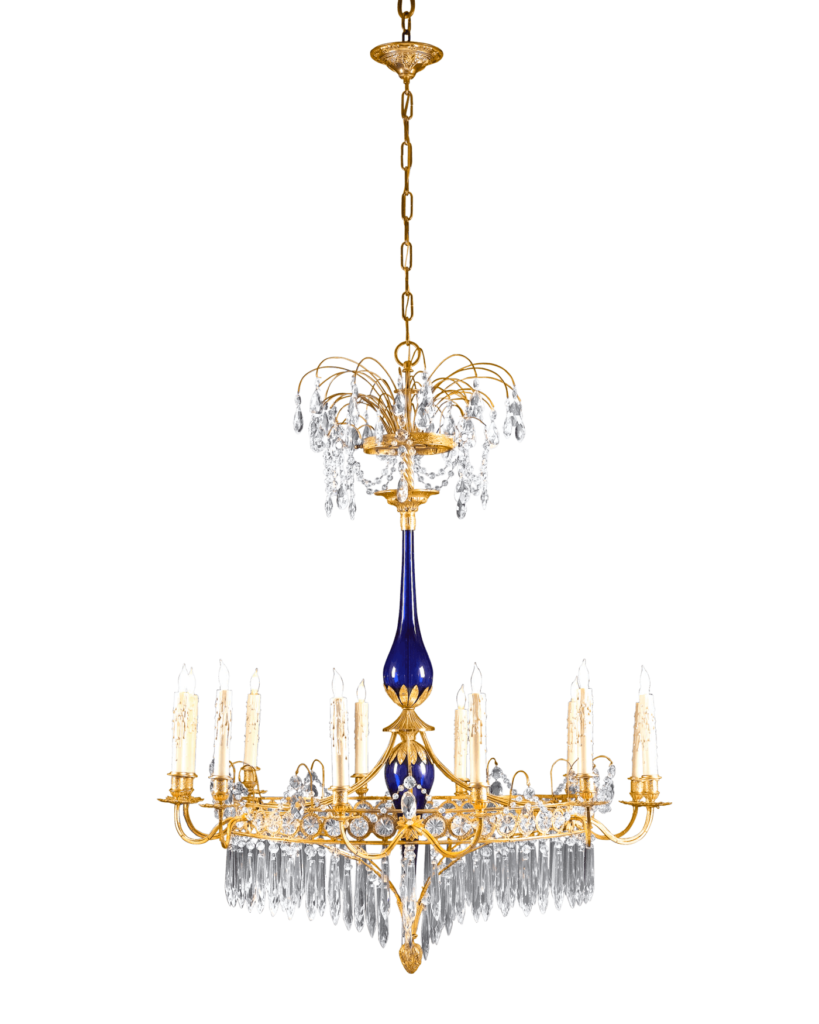
Consider purchasing a ceiling medallion to accompany your chandelier. While these decorative elements aren't absolutely necessary for hanging your chandelier, they can provide a finishing touch to your room, and are very handy at covering holes in the ceiling created by an old fixture.
Without question, a great chandelier can make the room. It can mean the difference between having a beautiful room and having a breathtaking room.
Product Spotlight: Murano Glass Chandeliers
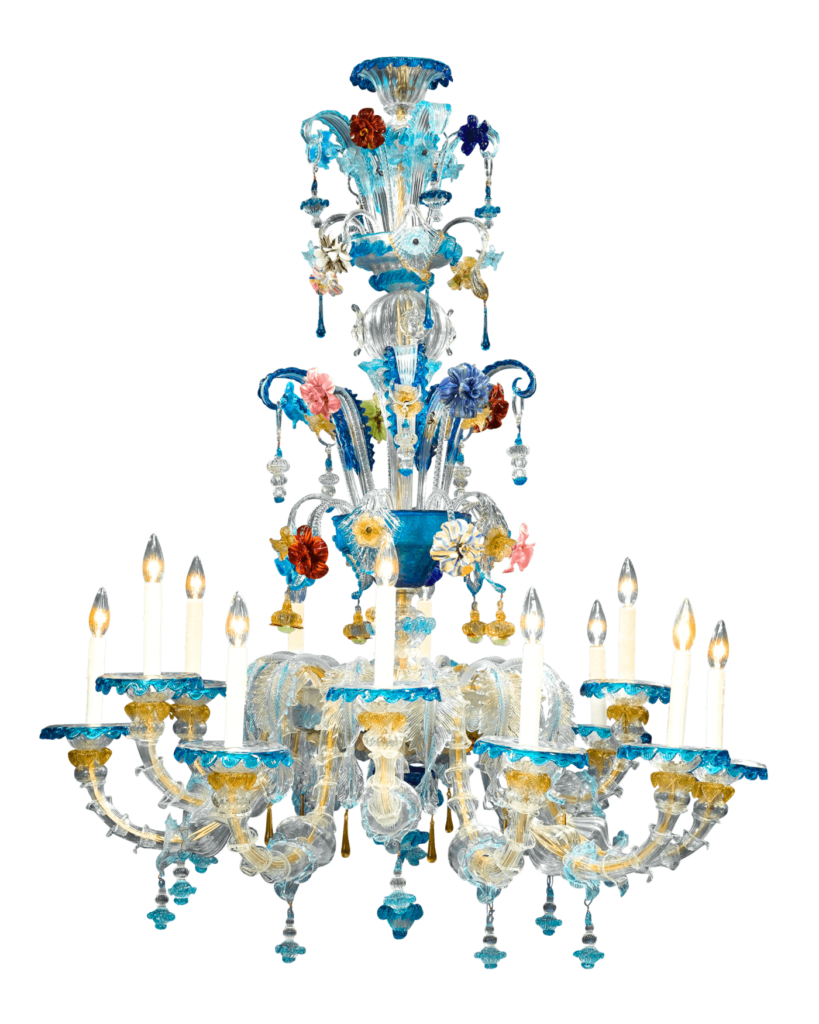
The medium of colored glass is one that’s been applied to numerous types of objects throughout history. From adorning, and essentially completing Gothic-style cathedrals in Western Europe, to topping glass lamps, colored glass is an indispensable form of art worthy of consideration.
While talented colored glass craftsman existed all over the map, it was the artisans on the island of Murano outside Venice who perfected the talent of adorning colored glass on to objects, such as chandeliers. By infusing their glass pieces with rich jewel tones such as vivid greens, striking blues, and deep purples, the result is a myriad of color, allure, and beauty.
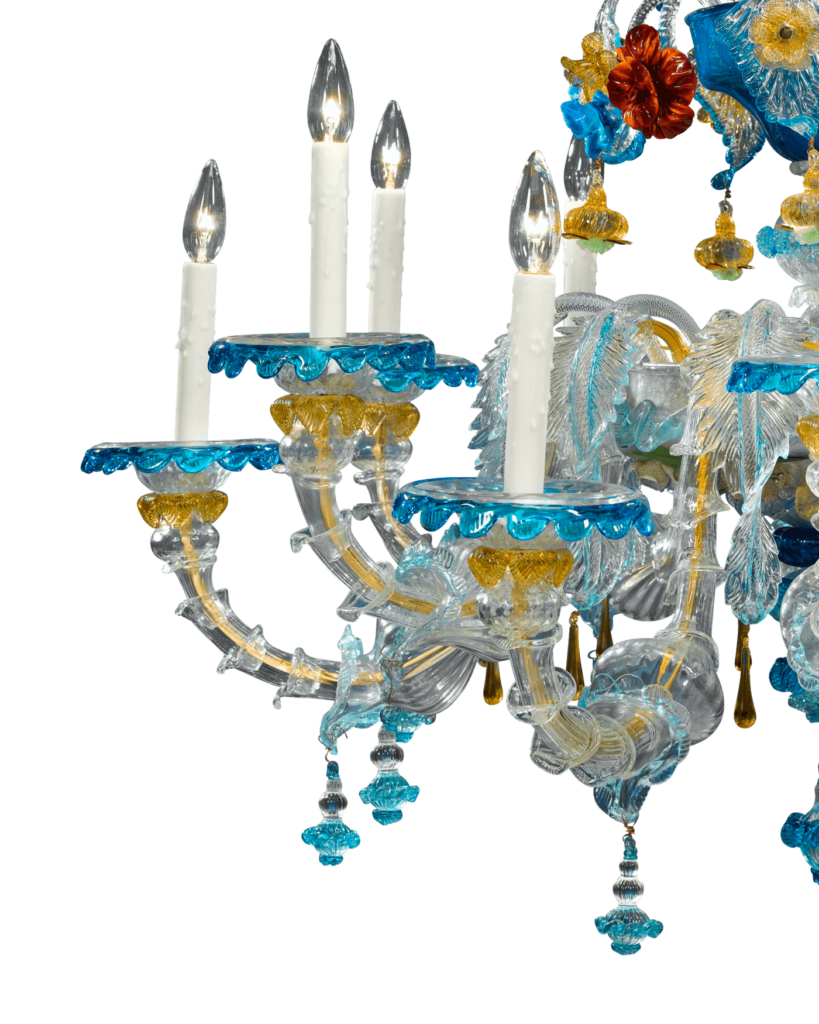
Today, Murano glass chandeliers are particularly sought after due to their remarkable rarity.
Shop our current selection of rare and remarkable chandeliers and antique lighting on our website
